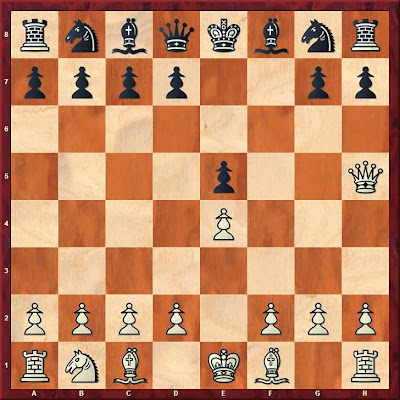The common moves 1.e4 e5 2.Nf3 reach a position where Black makes an important choice. Will Black defend the e-pawn or attack White's e-pawn. If Black chooses to defend the e-pawn, what defense will he or she adopt.
2...Qf6 is inadvisable. Our model game is Morphy -- McConnell 1849.
2...Bd6 is inadvisable. The model game comes from a correspondence game that I played in 2005.
This week we look at 2...f6, which may be the worst possible move. It is certainly the worst way to defend the pawn.
White to move
This manner of defense is shockingly common in scholastic tournaments. Consequently, a player who understands its pitfalls may find an opportunity to demonstrate this knowledge when it means an easy win in a tournament game.
This move is also a named opening: Damiano's Defense. Pedro Damiano (1480-1544) pointed out White's refutation of this error, and so it is a bit ironic to name the opening for him. During his life new chess rules were changing the nature of the game. Folks used the terms "new chess" and "old chess" to refer to the differences. The queen and bishop had become the pieces they are today. In the old chess, they were much weaker. 2...f6 was a strong move in the old chess. With bishops and a queen that could move all the way across the board, this move became terrible.
Our model game is the opening phase of a battle that took place in Rome in 1560. Ruy Lopez was a Spanish priest who had to be in Rome on church business. He also was one of the leading chess players in Spain. He spent his free time in Rome playing chess with the leading players of that city. His opponent in this game was Leonardo di Bona, who was nicknamed the kid.
3.Nxe5! fxe5??
2...f6 is an error, but not a game losing one. 3...fxe5 is a blunder. 3...Qe7 offers Black prospects for continuing the game.
4.Qh5+
While looking at the game Morphy -- McConnell, it was stressed that bringing out the queen early was usually an error. However, all strategy generalizations have exceptions. Clear analysis of the position on the board is more important than general strategy principles.
Black to move
Black has two legal moves. The better of the two loses a rook. White's third move looked like a knight sacrifice, but in fact it wins material. If Black tries to hang on to the extra piece, White can force checkmate or win a piece more valuable than the rook.
4...g6
The kid made the best move. He was prepared for this position, including the loss of his rook. He had a plan that he thought was better than the priest's plan.
5.Qxe5+ Qe7 6.Qxh8 Nf6
White to move
We see that Leonardo di Bona's idea was to trap the White queen. In this position, it has no safe move. However, Black still has some work to do before the queen can be captured. If Lopez succeeds in rescuing his queen, he will have a significant material advantage. If not, he should lose.
7.d4 Kf7 8.Bc4+ d5 9.Bxd5+ Nxd5
White to move
H.J.R. Murray, A History of Chess (1913) tells us that Lopez won this game, but the moves to this position appear to be all that have survived.
In Rome in 1560, Ruy Lopez proved that he was a better chess player than Leonardo di Bona. Fifteen years later, they played another series of games. The Kid had improved significantly. He traveled to Spain to prove his skills. He defeated Lopez and the other leading players of Spain.


















No comments:
Post a Comment